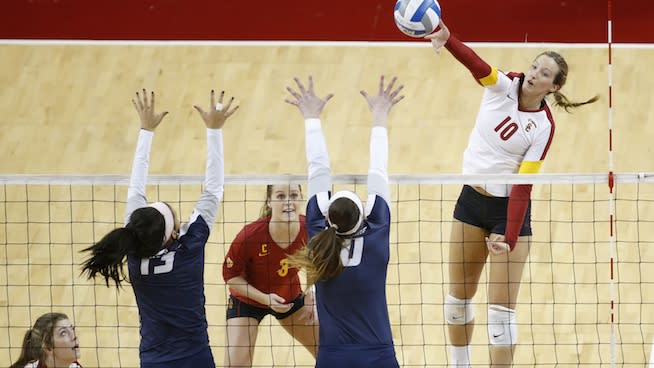Why the Landing Is Critical for the Volleyball Vertical Jump
As a volleyball player, your strength program should incorporate landing techniques as well as strength workouts that build the muscular systems needed to absorb landing forces.

Physical training (relative to strength and technique) may be the most practical and effective way to prevent injuries from jump landings. In a 1996 study, female athletes participated in plyometric jump training for six weeks. Thereafter, their maximum landing forces during blocks fell by 22 percent and adduction and abduction movements decreased by 50 percent. These improvements could prevent athletes from reaching the "position of no return," thereby subsequently reducing the incidence of injury. Interestingly, no change in vertical leap height was detected after training. Thus, it appears that training can improve landing mechanics without hurting performance.
At Alpha Athletics, we focus on the toe-heel landing technique and incorporate constant strength training of the lower extremities—the hamstrings, glutes, calves and anterior tibialis. Here are some of the exercises we incorporate to ensure "softer, more controlled" landings.
RELATED: Volleyball Workouts and Drills You Can Do At Home
Volleyball Landing Exercises
Box Drop-Offs (2 to 2, 2 to 1, and 1 to 1)
Drop off a moderately high box (12 to 24 inches) and perform a controlled landing of toe to heel. A 2-to-2 drop simply means you drop off with two feet and land on two feet. Concentrate on a good athletic stance when contacting the ground. This allows you to perform a secondary movement, be it another jump, a shuffle or a rotation.
Once 2 to 2 is performed with adherence to form, the progressions are 2 to 1 and 1 to 1. I can't stress enough that this progression is not assumed, and that technique is essential. With respect to 2-to-1 foot landing, the knee must track and align with the hip and shoulder, and you should absorb the force through dropping of the hips into an athletic stance.
RELATED: Increase Your Vertical With Depth Drops
Ankle Mobility
The ability of your ankles to absorb some of the landing force is essential to your vertical training program. This drill involves standing with your toes on a slight incline and moving into dorsiflexion by breaking your knees. Eric Cressey shows us this quick and easy drill in the following video:
Every volleyball player should have his or her landing analyzed. Take into account FMS (Functional Movement System) scores with respect to the Deep Squat and the Inline Lunge. Click here to learn more about the FMS test.
Reference
Hewett, T.E., Stroupe, A.L., Nance, T.A. and Noyes, F.R. (1996) "Plyometric training in female athletes: Decreased impact forces and increased hamstring torques." American Journal of Sports Medicine, 24(6), 765-773.
This article originally appeared on STACK.com: Why the Landing Is Critical for the Volleyball Vertical Jump

